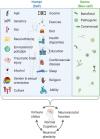Peripheral Pathways to Neurovascular Unit Dysfunction, Cognitive Impairment, and Alzheimer's Disease
- PMID: 35517047
- PMCID: PMC9062225
- DOI: 10.3389/fnagi.2022.858429
Peripheral Pathways to Neurovascular Unit Dysfunction, Cognitive Impairment, and Alzheimer's Disease
Abstract
Alzheimer's disease (AD) is the most common form of dementia. It was first described more than a century ago, and scientists are acquiring new data and learning novel information about the disease every day. Although there are nuances and details continuously being unraveled, many key players were identified in the early 1900's by Dr. Oskar Fischer and Dr. Alois Alzheimer, including amyloid-beta (Aβ), tau, vascular abnormalities, gliosis, and a possible role of infections. More recently, there has been growing interest in and appreciation for neurovascular unit dysfunction that occurs early in mild cognitive impairment (MCI) before and independent of Aβ and tau brain accumulation. In the last decade, evidence that Aβ and tau oligomers are antimicrobial peptides generated in response to infection has expanded our knowledge and challenged preconceived notions. The concept that pathogenic germs cause infections generating an innate immune response (e.g., Aβ and tau produced by peripheral organs) that is associated with incident dementia is worthwhile considering in the context of sporadic AD with an unknown root cause. Therefore, the peripheral amyloid hypothesis to cognitive impairment and AD is proposed and remains to be vetted by future research. Meanwhile, humans remain complex variable organisms with individual risk factors that define their immune status, neurovascular function, and neuronal plasticity. In this focused review, the idea that infections and organ dysfunction contribute to Alzheimer's disease, through the generation of peripheral amyloids and/or neurovascular unit dysfunction will be explored and discussed. Ultimately, many questions remain to be answered and critical areas of future exploration are highlighted.
Keywords: Alzheimer’s disease; germs; infection; modifiable risk factors; neurovascular dysfunction; peripheral amyloid hypothesis.
Copyright © 2022 Nelson.
Conflict of interest statement
The author declares that the research was conducted in the absence of any commercial or financial relationships that could be construed as a potential conflict of interest.
Figures



Similar articles
-
Alzheimer's disease.Subcell Biochem. 2012;65:329-52. doi: 10.1007/978-94-007-5416-4_14. Subcell Biochem. 2012. PMID: 23225010 Review.
-
Reciprocal Predictive Relationships between Amyloid and Tau Biomarkers in Alzheimer's Disease Progression: An Empirical Model.J Neurosci. 2019 Sep 11;39(37):7428-7437. doi: 10.1523/JNEUROSCI.1056-19.2019. Epub 2019 Jul 26. J Neurosci. 2019. PMID: 31350262 Free PMC article.
-
Plasma neuronal exosomes serve as biomarkers of cognitive impairment in HIV infection and Alzheimer's disease.J Neurovirol. 2019 Oct;25(5):702-709. doi: 10.1007/s13365-018-0695-4. Epub 2019 Jan 4. J Neurovirol. 2019. PMID: 30610738 Free PMC article. Review.
-
Neurovascular dysfunction and vascular amyloid accumulation as early events in Alzheimer's disease.Metab Brain Dis. 2022 Jan;37(1):39-50. doi: 10.1007/s11011-021-00814-4. Epub 2021 Aug 18. Metab Brain Dis. 2022. PMID: 34406560 Review.
-
ApoE4 effects on automated diagnostic classifiers for mild cognitive impairment and Alzheimer's disease.Neuroimage Clin. 2014 Jan 4;4:461-72. doi: 10.1016/j.nicl.2013.12.012. eCollection 2014. Neuroimage Clin. 2014. PMID: 24634832 Free PMC article.
Cited by
-
Neurovascular Dysfunction in Diverse Communities With Health Disparities-Contributions to Dementia and Alzheimer's Disease.Front Neurosci. 2022 Jun 29;16:915405. doi: 10.3389/fnins.2022.915405. eCollection 2022. Front Neurosci. 2022. PMID: 35844216 Free PMC article. Review.
-
Correlation Between Regulation of Intestinal Flora by Danggui-Shaoyao-San and Improvement of Cognitive Impairment in Mice With Alzheimer's Disease.Brain Behav. 2024 Nov;14(11):e70110. doi: 10.1002/brb3.70110. Brain Behav. 2024. PMID: 39482855 Free PMC article.
-
Arterial stiffness mediates the association between age and processing speed at low levels of microvascular function in humans across the adult lifespan.Am J Physiol Heart Circ Physiol. 2024 Feb 1;326(2):H346-H356. doi: 10.1152/ajpheart.00662.2023. Epub 2023 Dec 1. Am J Physiol Heart Circ Physiol. 2024. PMID: 38038715 Free PMC article.
-
Lung endothelium, tau, and amyloids in health and disease.Physiol Rev. 2024 Apr 1;104(2):533-587. doi: 10.1152/physrev.00006.2023. Epub 2023 Aug 10. Physiol Rev. 2024. PMID: 37561137 Free PMC article. Review.
-
Diabetic Encephalopathy: Role of Oxidative and Nitrosative Factors in Type 2 Diabetes.Indian J Clin Biochem. 2024 Jan;39(1):3-17. doi: 10.1007/s12291-022-01107-y. Epub 2022 Dec 16. Indian J Clin Biochem. 2024. PMID: 38223005 Free PMC article. Review.
References
-
- Abdi S., Alghamdi A. A., AlGhunaim N. N. A., Almutairi R. M., Ataya F. S., Ansari M. G. A., et al. (2022). Association of Alzheimer’s Disease with Genetic Variants of Apolipoprotein E, Clusterin, TNF-α and IL-6 Among Elderly Saudis. Curr. Pharm. Biotechnol. 2022:1389201023666220208093919. 10.2174/1389201023666220208093919 - DOI - PubMed
-
- Abou-Donia M. B., Lapadula E. S., Krengel M. H., Quinn E., LeClair J., Massaro J., et al. (2020). Using Plasma Autoantibodies of Central Nervous System Proteins to Distinguish Veterans with Gulf War Illness from Healthy and Symptomatic Controls. Brain Sci. 10:E610. 10.3390/brainsci10090610 - DOI - PMC - PubMed
-
- Al-Atrache Z., Lopez D. B., Hingley S. T., Appelt D. M. (2019). Astrocytes infected with Chlamydia pneumoniae demonstrate altered expression and activity of secretases involved in the generation of β-amyloid found in Alzheimer disease. BMC Neurosci. 20:6. 10.1186/s12868-019-0489-5 - DOI - PMC - PubMed
Publication types
Grants and funding
LinkOut - more resources
Full Text Sources

